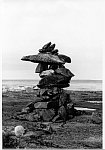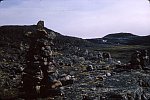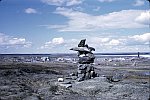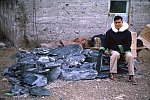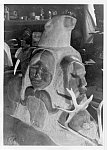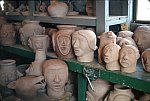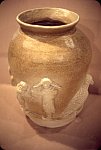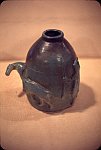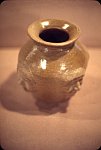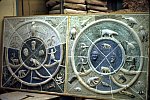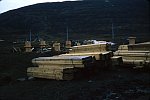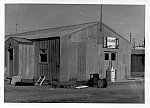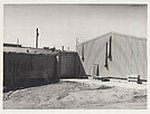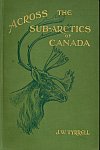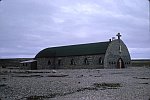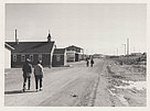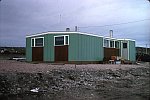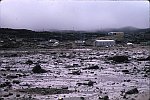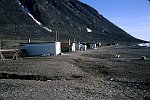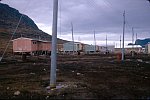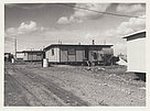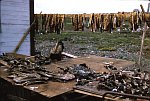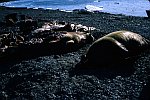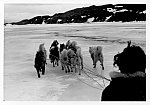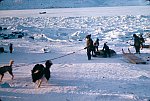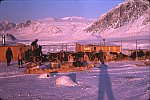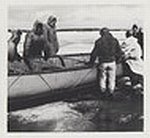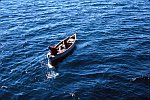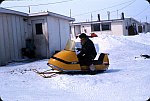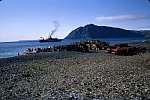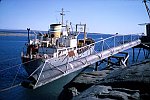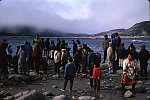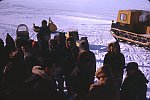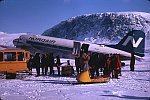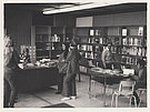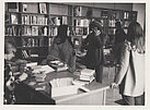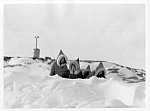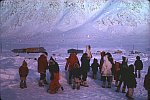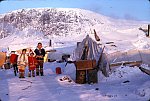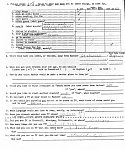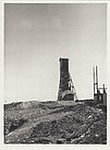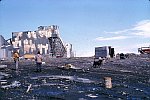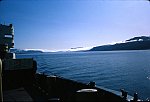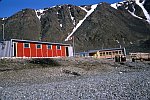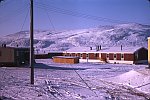Scenes from Nunavut
Author: Judith O. Stoute Page 1 | Page 2 | Page 3
Aspects of the Communities
1 – Arts and Crafts
�An estimated 30 per cent of Inuit derive some of their income from arts and crafts� (Nunavut, Government of Canada Folder, 1999). The arts and crafts industry began in 1948. At that time Inuit artwork was collected, and the following year it was exhibited in Montreal. Today, the same �traditional production techniques� are still used. Almost every region has an Arts and Crafts Centre with the Baffin Island region having the largest volume of artwork from clothing items to carvings. The works of ivory, soapstone and whalebone carvings as well as prints and tapestries can be found in museums and art galleries around the world.
One of the early art forms in Nunavut is the Inukshuk - meaning �like a person�. It is made of stone and served as an Inuit guide post which detracted the caribou into lakes or ravines for easy hunting. Other forms of art are the carvings and prints as above, pottery and sculpture.
Elders excelled at storytelling, and those stories are told on the pottery and prints with some of the latter being transferred to tapestries.
2 – Business
The Hudson�s Bay Company (HBC) was the first business venture in Northern Canada - then called Rupert�s Land - when the British Crown granted a charter to the company in 1670. Between the early 1900s and 1930s the HBC traded in fox furs with the Inuit - this was contract work; their own ships supplied the Eastern Arctic in the summer. In 1960, the fox fur trade was still on in some areas and today the HBC stores continue to provide important services.
The first co-operative in the Arctic was opened in 1959 at George River, Quebec. Co-operatives became important in the economy as general stores, and they were a training ground for northerners as other businesses later opened. In addition to general supplies, some co-operatives sell traditional food, local art and handicrafts as well as being involved in other services. In 1987, they were �the largest economic sector controlled by aboriginal people� (NWT Data Book, p. 91).
Some communities also have a Northern Store - supermarket.
3 – Character of the Inuit
An example of the character of the Inuit in the Barren Grounds area showed that on the one hand, the people are firm when dealing with others who wanted something from them which they, through necessity or urgency, did not want to give up. On the other hand, they could voluntarily provide valuable information to take the place of the thing wanted.
Sharing of their hunt so that no one is left out also reflects the character of the Inuit. They are also known to be a confident and patient people who accept circumstances as they come and hope for �better luck next time.�
4 – Churches
In 1993, the number of people in Nunavut who attended church was very high -�well above the national average� (Canadian Geographic, p. 25). Both Anglican and Roman Catholic missions were established at an early stage, dating as far back as 1894 at Pangnirtung for the former and from 1931 at Igloolik for the latter. In Igloolik an unusual-shaped stone church was built in the 1960s, replaced and then abandoned in the 1970s due to the high cost of heating the building.
5 – Housing
Dwellings were of different types; namely, canvas tents, skin tents, snow houses and sod houses. The same type was called by a different name: the Dorset people lived in snow houses and the Inuit in igloos; both of these winter shelters had stone lamps with whale blubber for light. Caribou and seal skin tents were the only kind used for summer hunting; later canvas tents were introduced, and both seal skin tents and canvas tents are still in use. A winter dwelling consists of two canvas tents with moss in between and covered with snow, wooden floors and some wooden walls covered with newspaper. Sod houses, built by the ancient people, were in use until the 1960s, and at that time canvas tents were also in use at camps.
Today, there are pre-fabricated houses from southern Canada, and functionally Inuit-built houses with material from the south of the country are being introduced in the Kivalliq region (Barren Grounds). Similar houses to the latter have been planned for the Baffin region. A functional house includes �a porch for the hunter to butcher meat or repair a snowmobile� (Wonders, p. 321). Other features mentioned are: (1) south facing windows for more sunlight and (2) a buffer structure across the front to protect against strong winds and to hold solar heat on bright days. In at least one community there are row-houses.
6 – Hunting and Fishing
�Hunting is the mainstay of Inuit culture. Many Nunavut families maintain their tradition of hunting caribou, muskoxen, fish and sea mammals for meat and furs� (Nunavut �99, p. 44).
Food
The food source is generally high in protein, especially for caribou, small game, birds and Arctic char. Some of the caribou is traded with other settlements or sold to large settlements, and the meat from the seal and walrus is used for both humans and dogs - walrus blubber when cooked tasted like bacon. If caribou is caught in the autumn, it, like moose, is fried or frozen to be used later; the hides, skins and other parts of animals are used for making a variety of products including clothing, handicrafts and carving materials. Traditionally, caches were made for meat, driftwood and miscellaneous fuel products; there were caches from the early autumn hunt for animals and from summer for fish. The food storage locations could be on rock or dry gravel and covered for protection with heavy boulders. These caches also had to be away from snowdrift areas and had to be found in the dark of winter. Foods are also dried and smoked as well as preserved with ice.
Clothing
In the past, �[t]he clothing of the Eskimo [was] made entirely of the skins of animals, chiefly of the seal and reindeer, the former being used for the summer and the latter for the winter� (Tyrrell, p. 128). Today, hides and skins are still used for some clothing and household usage: for example, muskox hides for clothing, polar bear skin for sleeping coverings, seal skin for boots and crafts and caribou skin in particular which has a very good insulation. Skins were also used for making small uncovered boats.
Transportation
Sleds pulled by dog teams and snowmobiles are the mode of travel in winter while boats are used in the summer. �The dogsled and the umiak, an open, uncovered boat that could carry twenty or more people, allowed Inuit groups to explore large stretches of new country rapidly and to exploit hunting opportunities over a wide area� (McGhee, p. 195). A similar structure, the oomiak, with a capacity for 30 or 40 people - was �chiefly used by the women for moving camp�; this �essentially freighting craft� was �never used in the hunt� (Tyrrell, p. 142). Sleds were made from driftwood and wood from wrecked ships. The Inuit also traded some of this wood with inland residents for instance those at Baker Lake. A komatik - a large wooden sled - can be pulled by five to fifteen dogs. Another snow vehicle is the autoboggan. Other forms of transportation in season are barges, canoes (some now have motors), kayaks, ships, small boats (which bring in and out the cargo from the ships) and year-round air service for passengers and cargo to and from southern Canada.
Traditionally men and women had defined areas of work. For example, the men were responsible for hunting, trapping and ice-fishing as well as making and repairing equipment and implements. The women for their part were responsible for the preparation of hides and skins for making clothing and miscellaneous items (they first used bone, then steel, needles with sinew thread), cleaning fish for drying, food processing and preserving as well as fishing.
7 – Leisure
In 1989, most settlements had a community hall and many had a library. The former was also used for the discussions on the land claims. Children, as elsewhere, play the familiar games and skate on ponds and smaller lakes. In addition the children of Nunavut play a game on ice floes just before the spring break-up of the sea ice. An individual traditional pastime is the string game. The men of the community play soccer on the sea ice and participate in dog team and snowmobile races. Both men and women engage in Inuit square dancing.
At a Rankin Inlet school in 1973, a leisure survey was conducted by two teachers (male and female) with thirty-six children (boys: 21 and girls: 15) between the ages of ten and fourteen. The survey consisted of thirteen questions of which reading, sports and listening to stories were among them, and the answers were to be chosen from three categories - �a lot�, �some� and �not at all�. On the whole, the results showed that for reading and sports, most of the boys and the girls chose the categories �some� and �a lot� respectively, while for stories, most of the boys chose �some� and most of the girls chose �a lot�.
8 – Mines
There have been three mines in Nunavut: North Rankin Nickel Mines (1955-1962) as above, Nanisivik Mines (1974-2002) and Polaris Mines (1982-2002).
The Nanisivik mine, at the place of the same name meaning �place where things are found�, was located on the south shore of Strathcona Sound off Admiralty Inlet northeast of Arctic Bay on Baffin Island. The mine site was bordered by very steep sedimentary cliffs and bluffs with very little vegetation. The area which was formerly uninhabited has Arctic char and caribou which are used by the residents of Arctic Bay. Nanisivik Mines Ltd., (Mineral Resources International Ltd.) was an underground mine which produced zinc and lead concentrate with silver. During the mine�s operation �about 25% of the workforce was Inuit mainly from Arctic Bay�, and Nanisivik had the only public port facility in the Eastern Arctic. The Annual Midnight Sun Marathon on July 1st was begun at Nanisivik in 1979 as �the world�s farthest north running event�.
The Cominco Polaris mine was located on Little Cornwallis Island, northwest of Cornwallis Island. This underground mine produced zinc and lead, and at the time of its operation, it was the world�s most northerly mine. Originally, Little Cornwallis Island �was thought to be a peninsula of Cornwallis Island but was shown [in 1957] to be separated ... as a result of aerial photography� (Prince of Wales Northern Heritage Centre, Northern Vignettes - Other Internet).
Both the Nanisivik and the Polaris mines were successful ventures; the former closed �because of ore exhaustion� and the latter �because of low ore demand� (Wonders, p. 234). The two mine sites did not have settlement status - the workers and their families lived at the sites during the operations.
9 – Schools
In 1989, there were full high schools (K-12) at Pangnirtung and Rankin Inlet and different levels at Arctic Bay, Baker Lake, Cape Dorset, Grise Fiord and Igloolik. Adult Education Centres were mentioned for all of the communities except Grise Fiord.
Conclusion
�One of Nunavut�s greatest challenges - and greatest strengths - is the age of its population, almost 60 per cent under 25. These young people will provide the leadership of tomorrow�. Respectful of the past, they are also comfortable with the technological tools of the present� (Nunavut, Government of Canada Folder, 1999). Both of these aspects will be needed by them in order to continue on the path set out by today�s leaders and supported by the people of Nunavut.

References
Books
- McGhee, Robert, Ancient People of the Arctic, UBC Press, Vancouver, in association with the Canadian Museum of Civilization, 1996.
- Morrison, William R., True North: The Yukon and Northwest Territories, OUP, Canada, 1998.
- von Finckenstein, Maria, Nuvisavik: The Place where we weave, Canadian Museum of Civilization, McGill-Queen’s University Press, Montreal, Kingston, London, University of Washington Press, Seattle, 2002.
- Wonders, William C., edited, Canada’s Changing North, Revised Edition, McGill-Queen’s University Press, 2003.
Miscellaneous Publications
- Canada�s North: The Reference Manual, Indian and Northern Affairs Canada, Amendment 1987.
- Canadian Geographic, March/April 1993, pp. 20-29.
- Canadian Geographic, January/February 1999, pp. 13, 34-46, 48-57.
- Northwest Territories Data Book, 1990/91, Outcrop Ltd., May 1990.
- Nunavut, Government of Canada Folder, Information Sheets and Map, 1999.
- Nunavut �99: Changing the Map of Canada, Nortext Multimedia Inc., and Nunavut Tunngavik Inc., 1999.
- The Canadian Encyclopedia, Year 2000 Edition, McClelland & Stewart Inc., Toronto.
